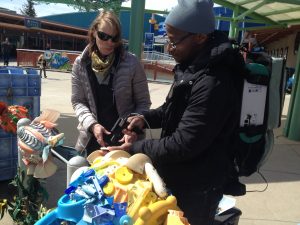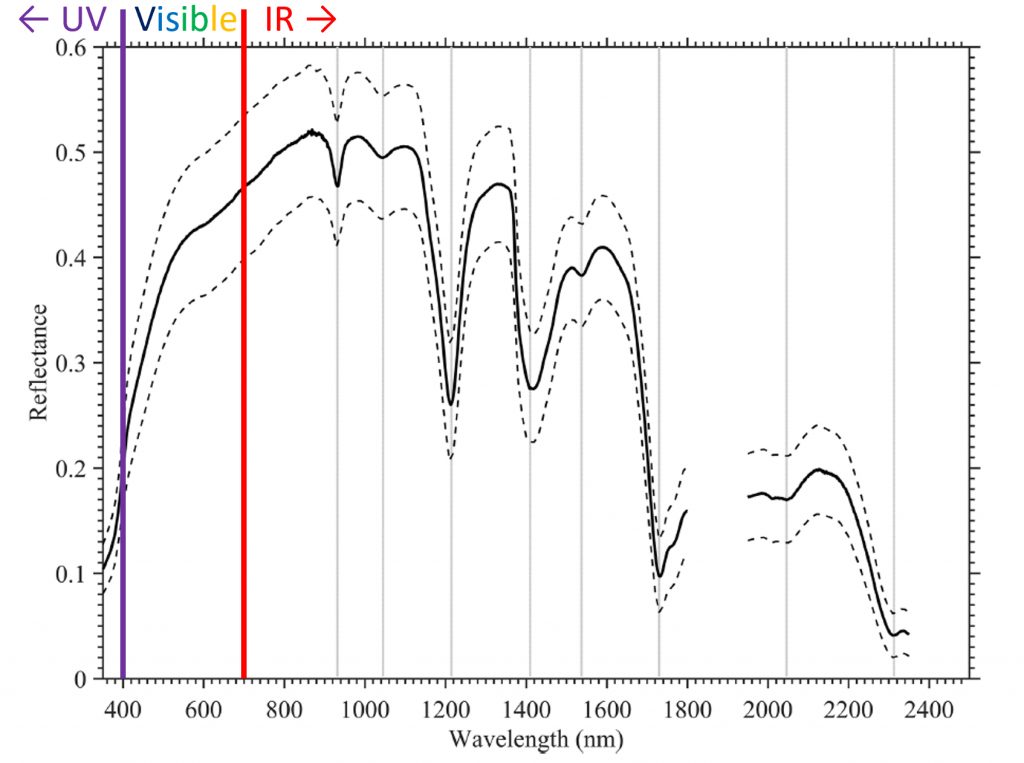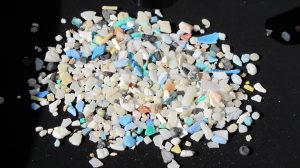
We’ve all heard stories about the garbage patches that are kilometers wide floating out in the ocean. While the garbage islands that many of us imagine are much closer to fiction, there is definitely a lot of plastic in the ocean, and most of it is in the form of microplastics (<5mm). This makes it difficult to identify and track the plastics that are floating around.
Satellites are able to find things like plankton blooms in the ocean by their spectral information (such as color). However, when it comes to plastics, they all have different colors and compositions and can be very small in size. This makes it tricky to distinguish plastic floating on the ocean surface.
In a recent publication, Professor Heidi Dierssen and a former postdoctoral researcher from her lab, Dr. Shungu Garaba now at the University of Oldenburg in Germany, built a database of the spectral information of many different types of plastics. They measured spectral reflectance, which represents the “color” of the objects, in the ultraviolet (UV), visible, and infrared (IR) parts of the spectrum. As explained in the publication, “The spectral reflectance of an optically active object (e.g. plastic, coral, seawater, algae, sediment) has a characteristic shape that explains how it can reflect or absorb light. The spectral shape is a combination of peak (reflection or fluorescence) features and trough (absorption) features that are distinctive optical properties of the objects.”
 The figure above is an example of a spectral reflectance measurement of marine microplastic particles, showing dips (troughs) of the curve highlighted with gray lines. These dips, called absorption features, are unique to the object and can help identify the type of plastic. Dashed lines represent standard deviation.
The figure above is an example of a spectral reflectance measurement of marine microplastic particles, showing dips (troughs) of the curve highlighted with gray lines. These dips, called absorption features, are unique to the object and can help identify the type of plastic. Dashed lines represent standard deviation.

Dr. Dierssen and Dr. Garaba sampled many different types of plastics that are representative of what would actually be found floating in the ocean. “Many research studies on marine plastics purchase new plastic bottles and other debris for their studies. This does not represent the actual objects found floating on the ocean surface and their environmental state,” Dierssen explains. The types of plastics that were sampled included microplastics (0.3- 5 mm), macroplastics (>5mm), and new plastic polymer pellets (for comparison). Microplastics were collected from the Atlantic and Pacific Ocean using surface-sampling nets. Macroplastics were sampled at the Mystic Aquarium, as part of a traveling exhibit raising awareness about plastic pollution, titled “Washed Ashore: Art to Save the Sea.” These plastics (buoys, containers, ropes, toys, nets, etc.) were collected from beach clean-ups on the West Coast. Dierssen describes that “their colors and material had been weathered by the sun and exposed to ocean turbulence. This provided a much closer library of real plastic objects that would be observed floating at sea than if we purchased new [plastics].”
The large plastics washed ashore are easily identifiable, but much less is known about the composition of the small microplastic particles found floating at the sea surface. To address this, Dierssen and Garaba also measured reflectance from new plastic pellets of 11 different polymer types. Absorption features of microplastics were compared to the plastic pellets to determine the closest matching spectral properties. The microplastics were most similar to low-density polyethylene and polypropylene often used in bottles and packaging material.
The measurements of the different types of plastics from this study are available in an open-access database as a reference for others. This data will help with remotely sensing and tracking plastics in the ocean, and eventually be used to identify the types of plastics floating around from satellites! As Garaba states, “Our contribution to the monitoring of plastics is the groundwork of understanding the key properties of plastics that can be used to develop algorithms/models/statistical approaches to derive essential descriptors about the plastics from remote sensing tools since these plastics have an optical signature or a unique light signal.”
Dierssen and Garaba recently submitted a NASA proposal to continue their collaboration to develop ways to remotely sense microplastic particles across the global ocean. Look forward to hearing more from them in the future!
Citation:
Garaba, S. P., & Dierssen, H. M. (2020). Hyperspectral ultraviolet to shortwave infrared characteristics of marine-harvested, washed-ashore and virgin plastics. Earth System Science Data. DOI:10.5194/essd-12-77-2020